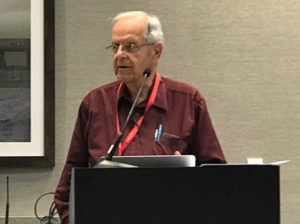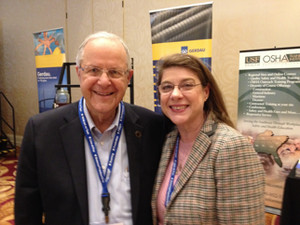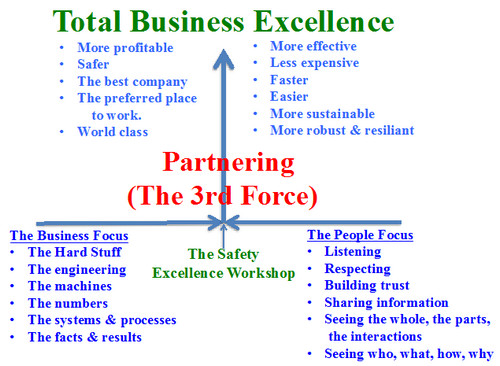In my last Safety newsletter, I wrote about the need to significantly improve our safety performance.
 I feel we are not moving fast enough to get to higher levels of performance. Way too many people are getting hurt and killed. Safety is a part of all we are doing and the whole system needs to be making improvements.
I feel we are not moving fast enough to get to higher levels of performance. Way too many people are getting hurt and killed. Safety is a part of all we are doing and the whole system needs to be making improvements.
A big step was taken towards this goal in a Safety II in Practice Workshop in Saint Petersburg, Florida, on February 24-27, 2019. This excellent gathering was organized and brought together by Tom McDaniel, a widely experienced, practical safety leader. One speaker was Eric Hollnagel who has written several books about Safety II. He summarizes Safety II as “the ability to succeed under varying conditions, so that the number of intended and acceptable outcomes is as high as possible. The Safety II perspective looks at how work goes well and tries to understand how that happens in order to ensure that it will happen again.” The shift from Safety I, where we look at what went wrong, to Safety II where we look at what is going right and learn from it is critical for our work to attain higher levels of performance.
Tom McDaniel spoke of our obligation to present the closest interpretation of the truth in our organizations enabling the people to be given enough information to make the best possible decisions. We need to engage the people to help to improve our total performance including safety and reducing the number of incidents and injuries. We need to understand and build upon the things that people are doing right. He shared many practical examples to illustrate this.
Ron Gantt spoke about the need to widen our gaze to see the complex interactions of everyday work so we can see opportunities for improvement and facilitation rather only violations. He talked about the importance of going into our organizations, being with the people and seeing how they really do their work and the challenges they face every day as they get the jobs done. It is important to close the gap between work-as-imagined and work-as-done.
Our Safety I habits are strong and it is not easy to move into a Safety II approach and sustain it. Safety I and Safety II are not in opposition to each other. Rather we need to take the best of the basic rules, procedures and skills of Safety I, and build the positive approach of Safety II into our way of working with the people at all levels in the organization so that everyone can be the best they can be.
 I was given the opportunity to talk about my work on Partner-Centered Leadership and shared information about the Process Enneagram, which is such a powerful tool to help people to come together to solve their complex problems. Partner-Centered Leadership is focused on sharing information, building trust and interdependence, helping everyone see the importance of their work for the success of the whole enterprise and moving into a better future. Everyone at the workshop was seeking ways to actually move into Safety II and make it happen so there was a lot of interest in this work.
I was given the opportunity to talk about my work on Partner-Centered Leadership and shared information about the Process Enneagram, which is such a powerful tool to help people to come together to solve their complex problems. Partner-Centered Leadership is focused on sharing information, building trust and interdependence, helping everyone see the importance of their work for the success of the whole enterprise and moving into a better future. Everyone at the workshop was seeking ways to actually move into Safety II and make it happen so there was a lot of interest in this work.
Tom McDaniel was gracious in commenting:
“Dick Knowles has the most effective process for understanding and measuring leadership and its advancement. His knowledge on this subject is outstanding. He brings clarity to what many are already doing in an ad hoc method but by seeing this relationship distinction, it can only help you and your organization move further along. I know he has written a couple of books on this. He has helped many organizations succeed.”
This Workshop was an exciting step into a brighter future for the people in our organizations. Many thanks to Tom McDaniel for having organized this workshop and bringing everyone together to share and learn.
 For our workplaces, this is about the way we think about safety, the way we engage around safety, and the way we bring a third unifying force to the whole culture of safety.It’s the missing link in our respective workplaces. Without it, we tend to stay engulfed in a culture of compliance, yet despite trying and trying, we never reach excellence. Without it, we keep repeating the same mistakes – round and round we go.
For our workplaces, this is about the way we think about safety, the way we engage around safety, and the way we bring a third unifying force to the whole culture of safety.It’s the missing link in our respective workplaces. Without it, we tend to stay engulfed in a culture of compliance, yet despite trying and trying, we never reach excellence. Without it, we keep repeating the same mistakes – round and round we go. I spoke about Partner-Centered Safety™ and the importance of this as the quickest way to achieve sustainable safety excellence. As many of you know, I have written and spoken about this many times over the last several years. The information and data I share clearly shows that this approach to leading safety is very powerful, producing improved results quite quickly. Many of you have seen the terrific results the people at the DuPont, Belle Plant achieved. This approach has a very strong scientific basis in complex adaptive systems theory.
I spoke about Partner-Centered Safety™ and the importance of this as the quickest way to achieve sustainable safety excellence. As many of you know, I have written and spoken about this many times over the last several years. The information and data I share clearly shows that this approach to leading safety is very powerful, producing improved results quite quickly. Many of you have seen the terrific results the people at the DuPont, Belle Plant achieved. This approach has a very strong scientific basis in complex adaptive systems theory.





